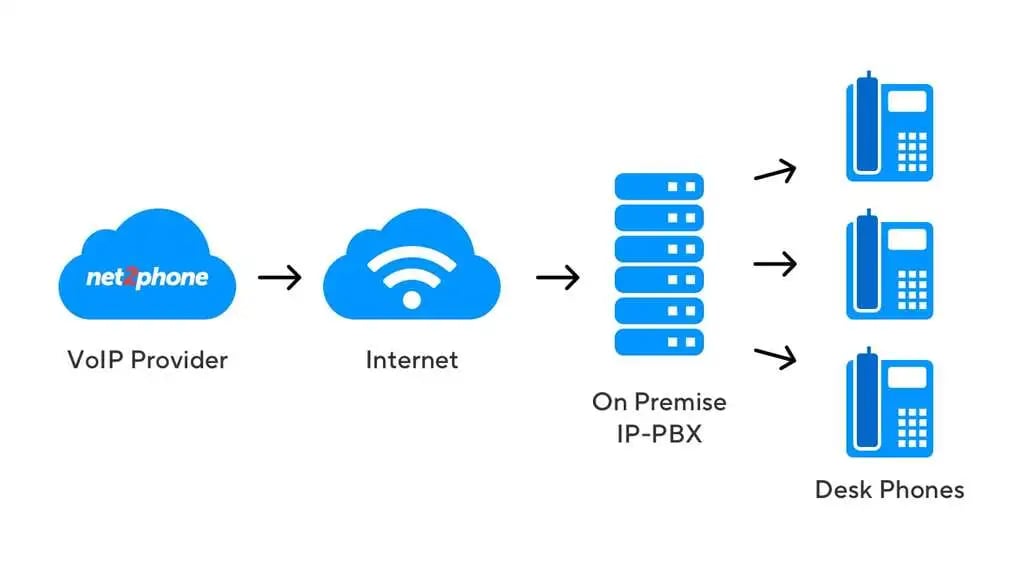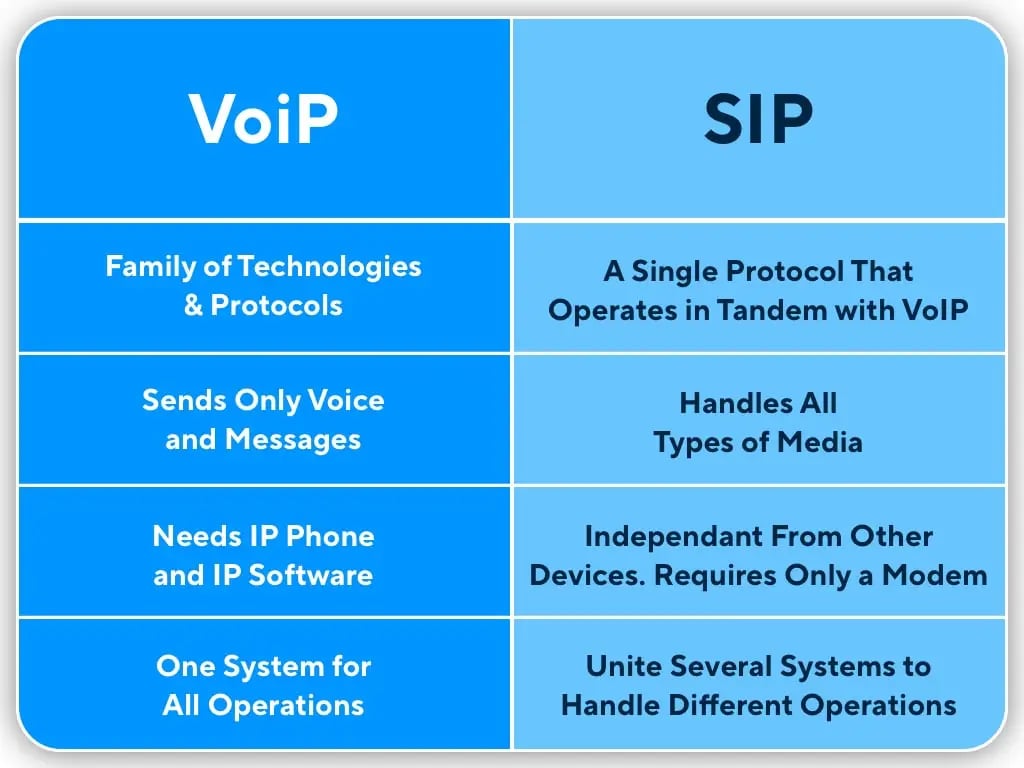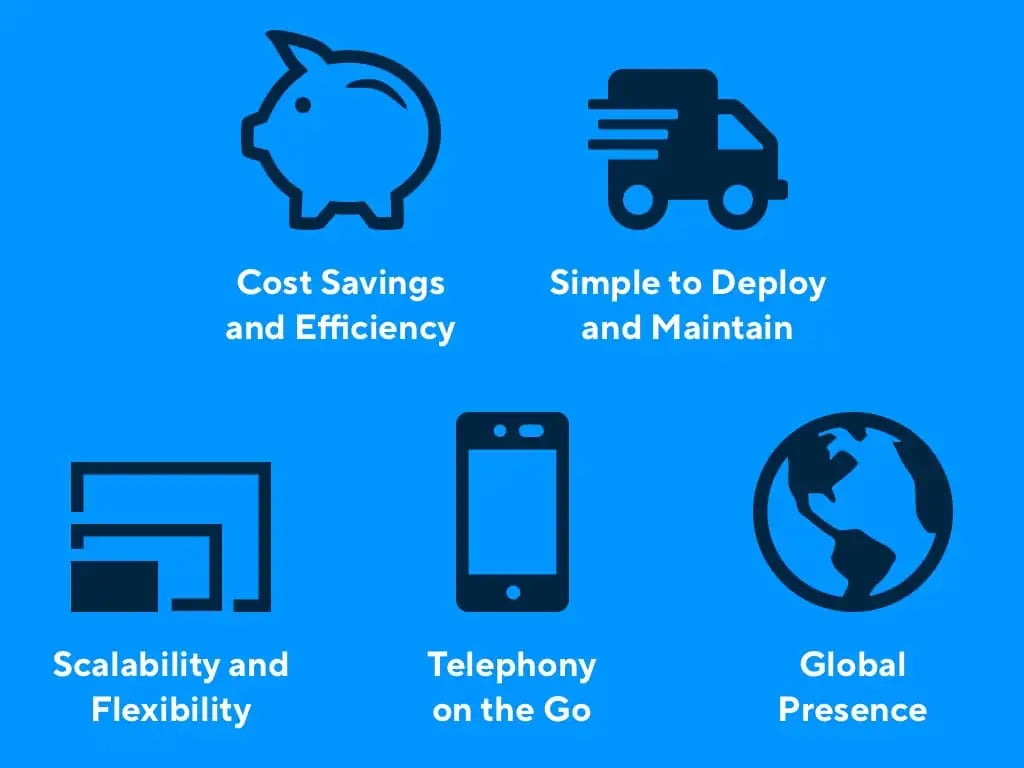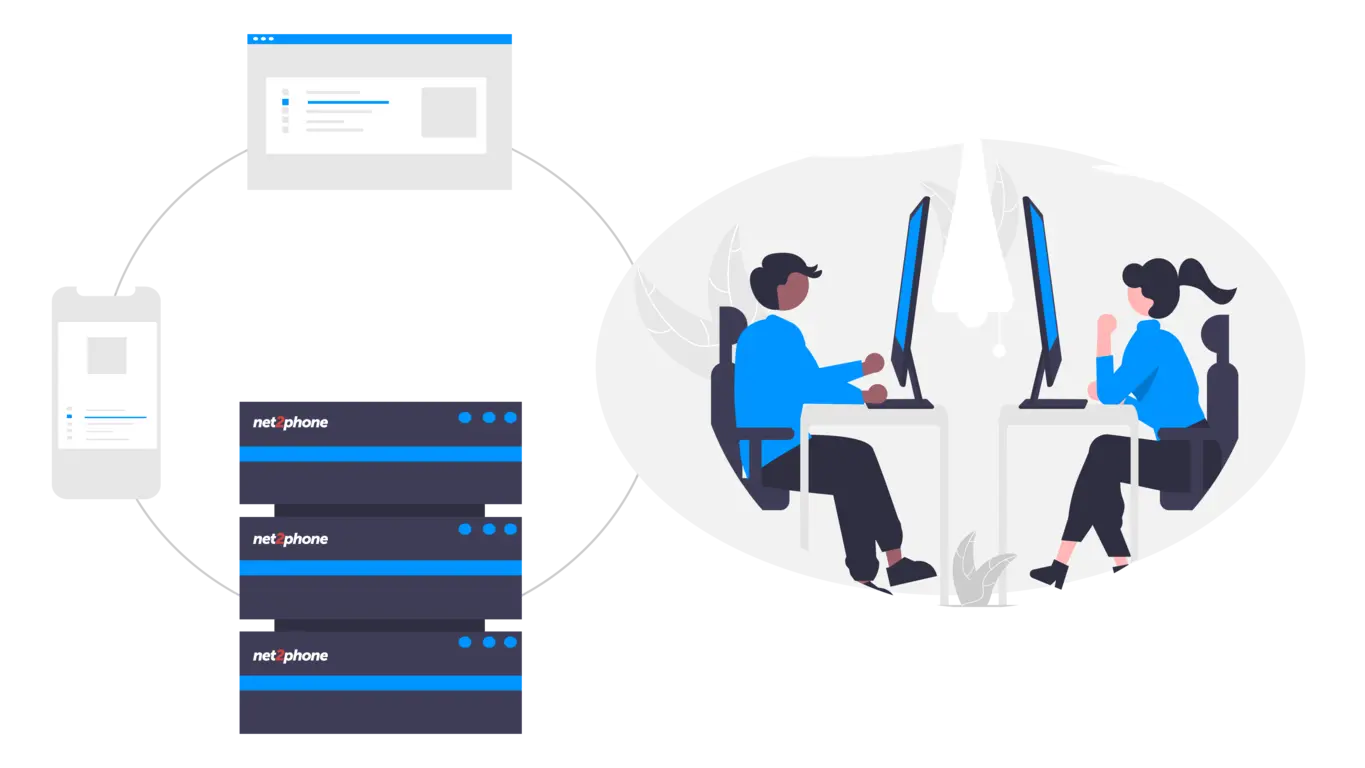Communications technology is transforming. Where companies would have once only had the choice of a traditional phone system for their communication needs, digital transformation has brought with it a host of enhanced options including, Cloud PBX, VoIP phone services, cloud contact center platforms, and SIP Trunking. These technologies have found new meaning in recent years – especially in the wake of the COVID-19 crisis.
Table of contents:
What is SIP Trunking?
Session Initiation Protocol (SIP) trunking is a digital alternative to traditional wire and cable phone lines that allows businesses to use their internet connection to make voice and video calls instead of traditional phone lines.

It involves connecting a business's PBX (Private Branch Exchange) to the internet via a SIP trunk, which serves as a virtual phone line. In other words, SIP Trunking is a digital alternative to traditional wire and cable methods of managing multiple phone lines.
Compared to an ISDN connection, SIP Trunking is established via a data network and is often used independently, as an alternative to ISDN. Although it’s not unusual for the two systems to be combined to offer a hybrid solution.
Related: SIP Trunking vs ISDN
What is SIP (Session Initiation Protocol)?
SIP, or Session Initiation Protocol is a method of data transmission used to set up connections between different devices including computers, desktop phones, mobile phones, video conferencing units, and file servers. It governs the establishment, termination, and time during phone calls as unique sessions.
SIP Trunks & SIP Channels
A trunk is now a set of "channels" each of which can handle a number of concurrent calls.
The number of channels you will need in your business is related to the number of concurrent inbound and outbound calls.
SIP trunks are usually sold by Sip Trunk provider in channels – with a channel considered as one incoming or outgoing telephone call. Typical enterprises require one channel for every three to four people – but do the math for your own business based on your standard working conditions and anticipated volume of calls.
Related: How Many SIP Trunks Do I Need?
How Do SIP Trunks Work?
By acting as the virtual equivalent of an analog telephone line, SIP trunks allow a communications provider to connect multiple channels to a PBX, thus allowing the operator to make and receive voice calls over the internet.
Essentially, the physical phone handsets, headsets, or other communication hardware in an office environment or contact center communicate with an on-premises PBX. The call is then routed through the SIP trunk/s and then connected to the internet to make Voice over IP web calls possible.

Related: How Do VoIP Phones Work?
Top SIP Trunking Features
SIP Trunking allows your business to enjoy flexible, reliable, and secure voice services with enterprise grade features, including:
- Unlimited calling
- Virtual phone numbers (DIDs)
- Hybrid SIP and Hosted environment support
- Enhanced quality of service (QoS) for voice communications
- Increased security
- Compatibility with most IP-PBXs and gateways
What Is The Difference Between SIP Trunking and VoIP?
SIP Trunking and VoIP operate in tandem to make web calls possible. They both refer to internet telephony but you shouldn’t directly compare SIP to VoIP.
VoIP, meaning Voice over Internet Protocol or Voice over IP, is a technology that enables the transmission of voice and other communications media such as text and video over an internet connection. SIP is one of those protocols.
The main difference between VoIP and SIP is that VoIP is a method of transferring voice and/or video data over the internet, while SIP provides the protocol necessary to initiate, manage, and end those calling sessions.

So, you can see how SIP trunks and VoIP work together to facilitate such communication features as:
- Voice calls
- Video conferencing
- Audio conferencing
- Messaging
Related: What is VoIP and How Does It Work?
SIP Trunking vs PRI
PRI (Primary Rate Interface) and SIP (Session Initiating Protocol) are two methods accustomed to connect your business to a telephone network.
PRI uses a T-1 transmission technology to make calls. It has been widely accustomed to support voice communications for over 40 years. A PRI circuit includes 23 voice channels to support 23 concurrent calls and one data channel to support call-related functionality like display while SIP Trunking uses an internet connection to make calls.
The main difference between PRI vs SIP is that PRI uses a traditional phone line while SIP uses the internet to make calls. Comparing PRI vs SIP Trunking, PRI can be argued to provide a better voice call quality due to the dedicated physical lines but it is less flexible, doesn't offer failover to mobile phones, and is more expensive to install and upgrade.
Top SIP Trunking Advantages

Cost Savings and Efficiency
Using a traditional landline phone system, you may be paying for the lines you aren’t using. A monthly service fee, equipment maintenance charges, and international call rates are high too.
With SIP Trunk service, you can effectively manage the budget and capabilities of your business phone system. At any time within a few minutes, you can increase or decrease the number of users and not pay for the extra ones. This means that you only ever pay for what you use and don’t waste money on unnecessary lines.
Simple to Deploy and Maintain
Not only is SIP trunking service simple to deploy — needing little in terms of onsite installation — it’s also simple to maintain.
Traditional systems require capital expenditure before they even arrive at the business premises. IP telephony however tends to use a monthly payment model and lines are deployed using software — often from a simple user interface.
Scalability and Flexibility
IP telephony not only requires little in the way of installation and ongoing maintenance, but is also incredibly flexible and highly scalable. Using the user interface, new users can be added quickly and with little fuss. If less telephone lines are needed, they can easily be removed too.
Should your startup be lucky enough to experience early high growth, the system can be easily scaled up to suit your needs and further features can be accommodated. For example, a popular choice, especially for call centers, is unified communications, a solution in which voice and data messaging is pulled together for more effective communication management.
Telephony on the Go
SIP trunking and IP telephony can also be easily routed to mobile devices and satellite offices to accommodate field and remote workers. As a startup, it’s likely that your field staff will be out selling, so the ability to have their work number routed to their mobile device can mean that they never miss out on a sale.
Remote working continues to rise too and for startups, teleworkers are often used in order to further cut costs. Using IP telephony, these employees and partners can work as if they are in the office, with a specific number for incoming calls, conferencing, voicemail and more.
Global Presence
With local phone numbers (DIDs) in over 300 cities, local infrastructure, knowledge, and staff we create an international presence for your business!
Why Should You Choose SIP For Your Business?
Because of the greater scalability, cost savings, flexibility and other benefits afforded by SIP Trunking, larger businesses with over 50 employees tend to choose it compared to other VoIP options.
SIP Trunking, depending on the PBX capabilities, can offer all the features and benefits a business would get with a hosted PBX, with additional efficiency and quality thanks to the removal of primary interfaces. Because phone lines can be shared across multiple locations, and audio and video are consolidated into a single line, the cost savings associated with SIP Trunking can also be significant.
“With the nature of the office transforming significantly during the pandemic, the need for a more flexible communications solution is top of the agenda for many businesses around the globe. Evidence suggests people are actively seeking out employers that provide the flexibility of a hybrid work environment. Providers can expect to see continued interest in services throughout 2022.” - Jonah Fink, CEO of net2phone.
The deciding factor when choosing between SIP Trunking and hosted PBX should be the size of the business. Smaller businesses will nearly always be better off with hosted PBX, as it provides all of the functionality of VoIP at little cost, both at the startup phase, and then later when it comes to maintaining the system. SIP Trunking, on the other hand, is better for larger businesses with more employees with existing PBX in place.
Related: Awesome Benefits of SIP Trunking
How to Get Started With a SIP Trunking Service?
If you are thinking of moving to the cloud to enjoy all of the benefits of a hosted solution, but already possess an on premises PBX system, then a move to SIP trunking should be an easy transition for you.
If you currently use ISDN2 or ISDN30 circuits, and have a leased-line or dedicated SDSL for your internet connections (as opposed to contended ADSL or WiFi), then SIP trunking should be a good fit for your organization.
Work Out How Many Channels You’ll Need
As we mentioned earlier, SIP trunks are usually sold by Sip Trunk provider in channels – with a channel considered as one incoming or outgoing telephone call. Each call takes up one channel.
if your business makes a lot of calls but receives relatively few ou won’t need more than one or two channels. But if your business receives a large number of concurrent incoming calls, you must ensure that there are enough channels to serve all of them.
Ensure You Have Sufficient Bandwidth
A SIP trunk shares the same connectivity environment as your IT infrastructure, so you’ll need to factor in the bandwidth requirements for trunking as part of your overall internet demand. Generally speaking, the faster your connection (broadband is ideal), the better the call handling.
Configure Your Business Router For QoS
If your business router has a Quality of Service or QoS setting (and it really should, for SIP Trunking), be sure to enable this, as it gives priority to voice traffic over other forms of data, and guards against delays that negatively affect audio quality.
Go For Unlimited International Calls
Your VoIP service should provide unlimited local calls (which may include Canada, if you’re in the continental United States). But your SIP plan should also include an uncapped number of overseas calls, charged at a fixed rate.
Use Complex Passwords For Authentication
As SIP trunks cross the public internet via IP addresses belonging to the telecommunications system, they’re vulnerable to hackers. So each session should be protected by a complex password which authenticates users to the SIP provider.
Limit Access To Your System
Draw up an approved list of personnel who are authorized to use your telephony system. The system itself should be isolated in a dedicated VLAN or Virtual Local Area Network.
Take Security Precautions
Measures to consider include an Intrusion Detection System (IDS) to monitor communications with your SIP provider, and a pass-code lock for international calls, to deter fraud.
How to Choose the Best SIP Trunking Provider?
When deciding on a SIP Trunking provider to handle the communication needs of your business, you want to make sure you are dealing with a company which understands the world of unified communications inside and out.
Your business’ ability to communicate with its audience is one of the most important parts of the operation, so you need to be confident the team providing your comms is a dedicated specialist which lives and breathes unified communications.
Don’t Get Locked Into A Fixed Contract - Your SIP provider should allow you to scale your service up or down (more channels or less), at any time.
Don't Get Caught By Hidden Costs - Initial setting up, monthly subscription fees, international call tariffs, any other fees or taxes – all of these should be spelled out in your contract.
Don't Accept Less Than A Tier-1 Network - At least a tier-1 network is required to provide the back end networking muscle for connecting calls to the Public Switched Telephone Network (PSTN). This is the minimum standard for business-quality voice transmission.
SIP Trunking FAQs
How much does SIP Trunking cost?
You may need to purchase a SIP-ISDN Gateway, and you’ll make an upfront payment to your SIP trunk provider to establish the connection and a monthly fee to maintain it. Beyond this, the call and operational charges should actually save you money.
Is SIP Trunking dependable?
As long as the equipment is well maintained, you have a solid internet connection, and the platform is operated by an experienced unified communications provider then, short of a power cut or internet service disruption, you should not experience any significant interruptions with SIP Trunking.
Is there a phone number limit using SIP trunking?
You are only limited by the number of trunks you can accommodate. It is easy to calculate how many SIP trunks you need. Each trunk has capacity for approximately 20 channels. Therefore, if, for example, your contact center needs to be making up to 100 calls simultaneously, you will need five trunks in total.
How to Switch to SIP trunking Service?
Get in touch with one of the friendly unified communications experts here at net2phone and we’ll be happy to talk though the process with you.






